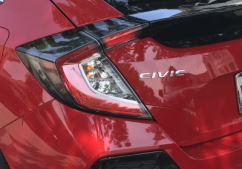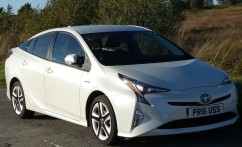 |
 07-26-2016, 02:35 PM
07-26-2016, 02:35 PM
|
#1
|
|
Registered Member

Join Date: Apr 2011
Location: IL/AR
Posts: 76
Country: United States
|
China Drivers Find Advertised Fuel Economy a Fiction
China Drivers Find Advertised Fuel Economy a Fiction - WSJ
Has anyone every been to an Asian country? If you have, you'll know that driving is completely insane compared to that of Western countries. I've had cab drivers literally mash the throttle and brake just to creep ahead in slow crawling city traffic. Plus all of the small streets, which are the size of American alleyways, riddled with potholes and speed bumps. Being an efficiency-minded driver, it made me cringe to think what fuel economy numbers they achieved with that type of driving.
__________________
|

|

|
 07-26-2016, 04:33 PM
07-26-2016, 04:33 PM
|
#2
|
|
Registered Member

Join Date: Apr 2011
Location: IL/AR
Posts: 76
Country: United States
|
I will quote the article since it's behind a paywall after a few visits:
Quote:
China Drivers Find Advertised Fuel Economy a Fiction
The testing method employed in the world’s biggest auto market falls short, critics say
SHANGHAI—In two years on Shanghai’s traffic-clogged roads, Lu Yi says, his BMW has guzzled gasoline at twice the rate advertised when he bought it.
His car’s official fuel economy of about 33 miles a gallon “can only be achieved on expressways,” not in Shanghai’s stop-and-go traffic, said Mr. Lu, a finance manager for a U.S. bank.
“Fuel-economy figures aren’t reliable at all in China,” he said.
The reason, say analysts and environmentalists: The testing method employed in the world’s biggest auto market falls short.
World-wide, auto testing has become a source of scandal. Just in the past year Volkswagen AG has admitted to years of cheating on emissions tests, and Mitsubishi Motors to decades of falsifying mileage data in Japan. In 2014, South Korean auto makers Hyundai Motor Co. and Kia Motors Corp. agreed to pay a combined penalty of $300 million to the U.S. for overstating fuel-economy claims.
All this is putting policy makers under pressure to roll out tougher standards.
In China the testing is carried out by the car makers themselves, and representatives of BMW, General Motors Co., Ford Motor Co., Volkswagen, Toyota Motor Corp., Honda Motor Co. and Daimler AG told The Wall Street Journal that their companies comply with Chinese regulations.
The problem, said Wu Zhixin, deputy director of China Automotive Technology & Research Center, a government agency that helps draft regulations, is that the current tests are outdated. “We aim to make future test cycles much closer to the real-world road conditions,” he said.
“China’s fuel-economy tests ignore some important real-world driving conditions, such as traffic congestion, air-conditioning use and bad weather,” said Kang Liping, a project manager for the Innovation Center for Energy and Transportation, a clean-transportation think tank backed by U.S. funds.
China’s roads grow ever more crowded—at the end of last year there were four times as many cars as a decade before, and only 35% more road. The official test simulates city driving in stop-and-go traffic by running the cars at between 20 and 50 kilometers an hour—a range set in 2004, when fuel-economy standards were introduced for some passenger vehicles. In real life, car speeds in the country’s 45 major cities last year averaged 29.6 kilometers an hour, according to Chinese online map purveyor AutoNavi Software Co., slowing to 26 kilometers an hour during rush hour.

As for the air conditioner, it can increase fuel consumption by up to a third, according to the Innovation Center, which says cars in China consume about 30% more gasoline than advertised. By contrast, U.S. drivers report mileage 12% better than official estimates, according to a study by AAA, a U.S. motorists organization.
The fuel-economy tests are conducted in labs on roller test benches. Car makers report the data to the government, and it is verified by third-party laboratories certified by the Ministry of Industry and Information Technology. The ministry didn’t respond to a request for comment.
“It’s hard to accuse manufacturers of manipulating fuel economy, because of loopholes in Chinese tests,” said Ma Yong, deputy secretary-general at the nonprofit China Biodiversity Conservation and Green Development Foundation, which is collecting information about fuel-economy discrepancies. Faced with a discrepancy between the lab results and what an actual driver gets, a car maker can cite factors like “aggressive driving habits and road congestion,” he said.
Said a BMW AG spokesman in China, “real-world fuel consumption may differ from official fuel consumption.” One sign of a discrepancy: Car makers’ own data shows many models with higher fuel-economy ratings in China than in the U.S.
Stricter test standards will be submitted to the government by the end of next year, said Mr. Wu. It’s unclear when China will adopt them. “Even if the government approves, car makers will be given a couple of years of reprieve,” he said.
For now, some Chinese drivers are taking matters into their own hands. Zhang Xiong says his Xiaoxiongyouhao app, used to track fuel consumption, has been downloaded 2.5 million times and has on average 300,000 active users every month. He created it in 2009, he said, after finding that his Chinese FAW Besturn’s fuel consumption was running around 25% higher than claimed.
“I wanted to know how to save fuel,” Mr. Zhang said. The app has recorded more than 10 million pieces of fuel-consumption data covering more than 80 brands in China.
Auto makers’ fuel-economy challenge is about to become tougher. To ease pollution and reduce fuel imports, China has ordered an increase in average fleet fuel efficiency by 2020 to 5 liters per 100 kilometers, or about 47 miles a gallon—a 27% reduction in fuel consumption from last year’s level. Manufacturers that fail will face financial penalties and restrictions on expansion and new-car launches.
|
|

|

|
 07-26-2016, 11:07 PM
07-26-2016, 11:07 PM
|
#3
|
|
Registered Member

Join Date: May 2014
Posts: 464
Country: United Kingdom
Location: East Yorkshire
|
Is India in the same category? You'll find Indian drivers on Fuelly if you want to compare the same models on Indian, US and European roads.
I've not seen any Chinese flags here yet...!
__________________
 
|

|

|
 07-26-2016, 11:17 PM
07-26-2016, 11:17 PM
|
#4
|
|
Registered Member

Join Date: Aug 2009
Posts: 3,385
Country: United Kingdom
Location: Mid Wales
|
Did you see my other topic "cheating the test"? This is common practise the World over, I'd say it's even worse in Europe, in some cases , cars claim to get almost 40 MPG MORE than they actually do. A few small diesels like the Peugeot 208 and VW Polo actually got over 100 MPG in the lab tests!
I'm pleased some manufactures are already gathering real world data, Citroen, Peugeot etc but it only highlights how bad the overstated figures are. Next year, every car will use a different test cycle in Europe, to more accurately represent real World driving figures.
|

|

|
 |
 Posting Rules
Posting Rules
|
You may not post new threads
You may not post replies
You may not post attachments
You may not edit your posts
HTML code is Off
|
|
|
|
 » Car Talk & Chit Chat
» Car Talk & Chit Chat |
|
|
|
|
|
|
|
|
|
|
 » Fuelly iOS Apps
» Fuelly iOS Apps |
|
|
|
|
 » Fuelly Android Apps
» Fuelly Android Apps |
|
|
|
|
|